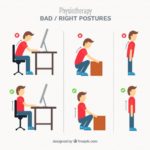Smartphones are such an integral part of our lives now that it’s no longer a question of if they’re changing us. It’s how. This generation is drastically redefining the use and design of smartphones. And in turn, our digital companions are altering our bodies and minds. Read on to find out how they affect us physically and mentally.
1. Posture
 You are probably looking down at your smartphone to read this post right now. This habit that we have of dipping our heads to stare at our phones while we’re walking or sitting is detrimental to our spines. It can cause a hunch in the shoulders, neck pain and faster spinal degeneration. According to a study by US National Library of Medicine , prolonged use of smartphones can cause a great deal of damage to posture. Not only that, the study found evidence that points to significant respiratory damage as well.
You are probably looking down at your smartphone to read this post right now. This habit that we have of dipping our heads to stare at our phones while we’re walking or sitting is detrimental to our spines. It can cause a hunch in the shoulders, neck pain and faster spinal degeneration. According to a study by US National Library of Medicine , prolonged use of smartphones can cause a great deal of damage to posture. Not only that, the study found evidence that points to significant respiratory damage as well.
You can take steps to ensure that your smartphone doesn’t permanently damage your posture. Make the conscious effort to keep your phone at eye-level rather than having to bend your neck to look at it. This simple measure can make all the difference when it comes to your spine, neck, and posture.
2. Sleep
 The human body recognizes the time of the day mainly with two wavelengths of light: red light and blue light. Blue light tells the body that it’s daytime, while red light indicates evening or nighttime. Our smartphones emit large quantities of blue light. This is the reasoning behind the fact that using your smartphones at night causes loss of sleep. When you’re using your phone in the darkness, you’re essentially tricking your body into thinking it’s daytime!
The human body recognizes the time of the day mainly with two wavelengths of light: red light and blue light. Blue light tells the body that it’s daytime, while red light indicates evening or nighttime. Our smartphones emit large quantities of blue light. This is the reasoning behind the fact that using your smartphones at night causes loss of sleep. When you’re using your phone in the darkness, you’re essentially tricking your body into thinking it’s daytime!
If you’re an Android user, apps like Twilight and Blue Light Filter – Night Mode help reduce or eliminate blue light so your phones don’t cause as much damage when you use them at night. iOS users can avail the inbuilt setting called Night Shift in the Display & Brightness panel.
However, the best solution to avoid sleep loss due to smartphones is to avoid using them after dark!
3. Texting Thumb
De Quervain’s tenosynovitis or radial styloid tenosynovitis is a swelling of the thumb tendons due to repeated movements. This painful condition is more popularly known as ‘texting thumb’ because constant texting happens to be one of its most common causes. Pain or tenderness in the base of the thumb is the biggest symptom of texting thumb. Our thumbs get the most exercise when we’re using our phones, be it texting or scrolling or playing Candy Crush. Texting thumb is an increasingly common condition among teenagers.
WARNING: Do not self-diagnose or self-medicate under any conditions. Seek medical assistance and professional opinions if you’re experiencing pain in your thumb region.

4. Selfie Culture
 Around 73 selfie-related deaths were reported globally in 2016. What is it about this obsession with selfies that is endangering so many lives? The mere desire for likes and retweets is enough for someone to endanger their life.
Around 73 selfie-related deaths were reported globally in 2016. What is it about this obsession with selfies that is endangering so many lives? The mere desire for likes and retweets is enough for someone to endanger their life.
One article by pcmag from 2016 reveals that a Ph.D. student from Carnegie Mellon University is developing an app that warns selfie enthusiasts by detecting the location around them. If someone were to take a selfie in front of a train track or from a dangerous height, the app warns them. However this potentially life-saving technology’s success is yet to be proven.
5. Nomophobia
 You know acrophobia is the fear of heights, claustrophobia is the fear of enclosed spaces. Wondering what nomophobia is? It is the fear of being without your cellphone. Almost all of us are greatly dependent on our smartphones. We use it for GPS, weather reports, texting, taking photos, staying in contact with people, and social networking. So, maybe, if you’re out one day and realize you’ve forgotten your phone at home, you feel a little uncomfortable. If you try you can actually go about your day normally even without a smartphone.
You know acrophobia is the fear of heights, claustrophobia is the fear of enclosed spaces. Wondering what nomophobia is? It is the fear of being without your cellphone. Almost all of us are greatly dependent on our smartphones. We use it for GPS, weather reports, texting, taking photos, staying in contact with people, and social networking. So, maybe, if you’re out one day and realize you’ve forgotten your phone at home, you feel a little uncomfortable. If you try you can actually go about your day normally even without a smartphone.
Nomophobia is an extreme case in which a person experiences heightened levels of anxiety, insecurity and even depression because of withdrawal from their smartphones. This unfortunate condition is increasingly prevalent these days. So if you are addicted to your smartphone and feel incomplete without it in your pocket, it’s time to reassess. The best way to prevent smartphone addiction is to measure usage. Keep track of how often you check your devices and schedule timely breaks to relax your eyes and your mind.
Our phones are nothing but a handy convenience; we don’t need them to function as normal human beings. It’s high time we get smart about using our smartphones!
Image Source: Google Images
Also published on Medium.